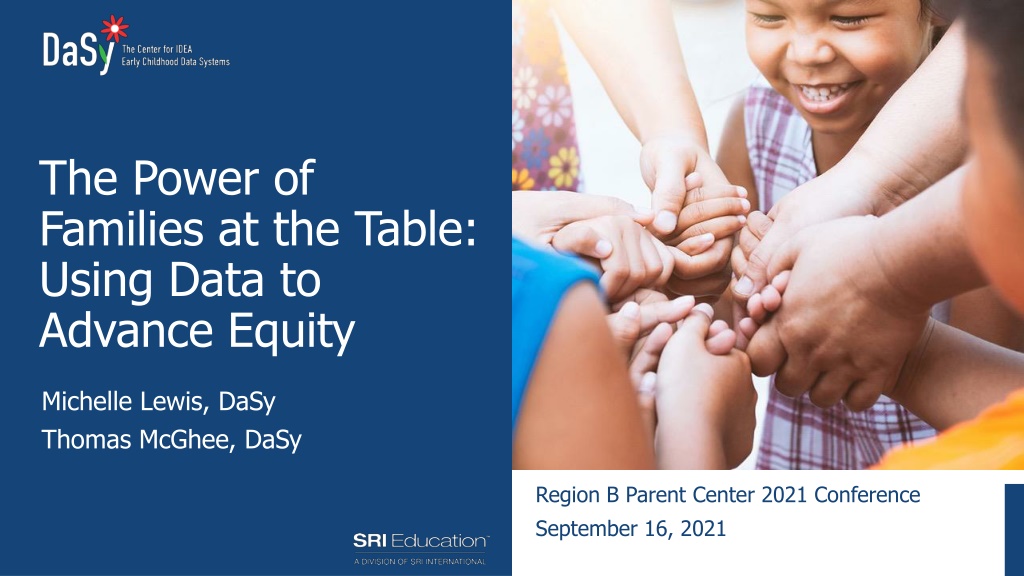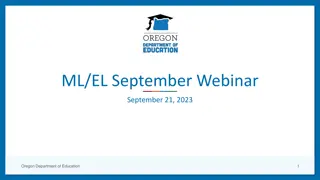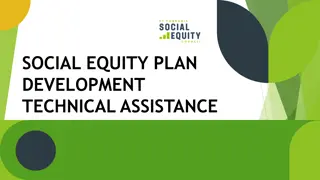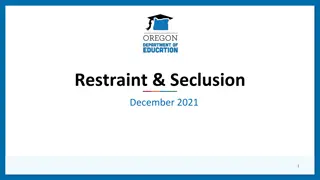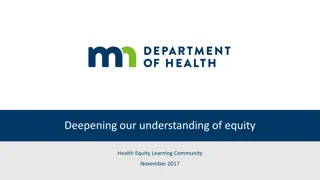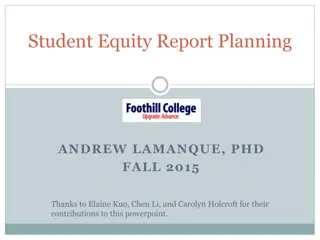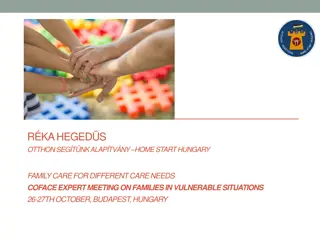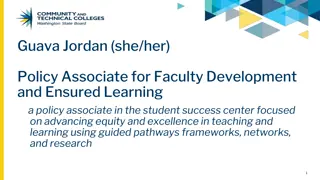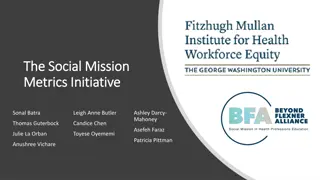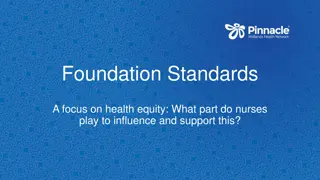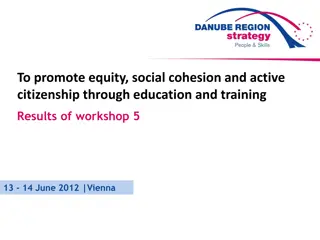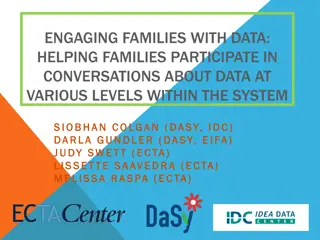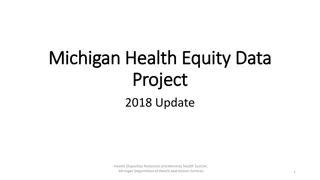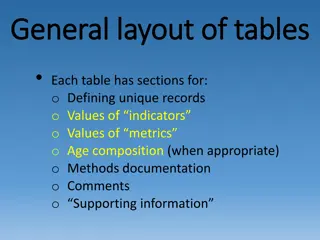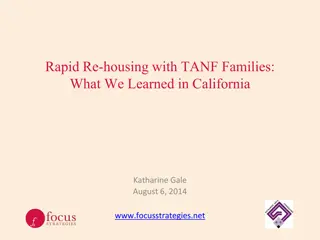The Power of Families at the Table: Advancing Equity Through Data
Explore the crucial role of families in effective data teams, strategies for engaging stakeholders, and using data to address inequities in the context of early childhood systems. Discover the meaning of equity, how data can help achieve it, and why it is essential for achieving positive outcomes for children and families.
Download Presentation

Please find below an Image/Link to download the presentation.
The content on the website is provided AS IS for your information and personal use only. It may not be sold, licensed, or shared on other websites without obtaining consent from the author. Download presentation by click this link. If you encounter any issues during the download, it is possible that the publisher has removed the file from their server.
E N D
Presentation Transcript
The Power of Families at the Table: Using Data to Advance Equity Michelle Lewis, DaSy Thomas McGhee, DaSy Region B Parent Center 2021 Conference September 16, 2021
Session Outcomes Participants will be better able to: Articulate the role of families and community members on effective, equitable data teams Apply potential strategies for engaging stakeholders in meaningful data conversations Collaborate with stakeholders and community partners to use and interpret data to understand and address inequities 2
Reasons to collect and use data: Assess and improve quality of services that benefit children and families Examine gaps in access to needed services and supports Advocate for federal, state, and local policy change and investments Increase public awareness and understanding Build trust within and across communities and systems Achieve positive and equitable outcomes for children and families How are families engaged and empowered in achieving these purposes of data use? 3
Equity within the Early Childhood Context Achieving the outcomes we want for all young children requires an intentional focus on equity. That means understanding the current conditions in your community that contribute to disparities among different populations, and how those conditions affect families. Equity in Early Childhood Systems: A Community Action Brief, Center for the Study of Social Policy, National Collaborative for Infants & Toddlers 4
What do we mean by equity? Equity is fair treatment, access, opportunity, and advancement for all people, while at the same time striving to identify and eliminate barriers that have prevented the full participation of some groups. The Early Childhood Data Collaborative defines racial equity in two ways: 1. As an outcome: Our race no longer predicts how we fare 2. As a process: The work it takes to get there Adapted from Early Childhood Data Collaborative. See more here: https://earlysuccess.org/data-and-racial-equity-in-early-childhood-policy 5
How can data help? Addressing inequities requires an understanding of the root causes of outcome disparities within our communities Evaluating disaggregated data can help identify inequities, but data are not meant to be interpreted in a vacuum. It s important to remember that data can and have been used to harm groups and communities. To use data to help identify and reduce inequities, it s critical to look at data with families and communities and listen to lived experiences. Questions to consider: Who collected the data? Whose lives are embodied in the data? Who is it serving? Who is harmed potentially? Adapted from Data Feminism. See more here: https://data- feminism.mitpress.mit.edu/ 6
What are Data Teams? Data teams are groups of individuals dedicated to using data to plan and make decisions about programs and services. Teaming for Data Use 7 Image from the Data Culture Toolkit: Supporting State and Local Data Use See more here: https://dasycenter.org/data-culture-toolkit/
Family and family organization stakeholders come to the decision-making table with Unique life stories that give them motivation to serve as thought leaders and change agents on behalf of all children and families, not just their own. Different levels of access to information and support. Different experiences with using data in both their personal and professional lives. Intersectional identities that inform their understanding of the data (e.g., identifying as female and Asian American). Varied feelings about today s data-rich culture. Considering intersectional identities is not about adding one aspect of identity to another. It is about how people with overlapping identities experience systems of power. 8 (Catalyst, 2020)
To effectively serve as program stakeholders, families and family organization representatives need to Understand why data are important; Understand what data are being collected and how those data are used; Know who is involved in data conversations and their roles in decision- making; Understand how they are/can be involved in data use. It is essential to create a safe environment and provide support for families to feel comfortable asking questions about data. 9
Assembling the Table Consider these questions throughout the process to ensure no one is overlooked: Who will be representing the interests of the individual community members whose data are being used? Which people or organizations will be affected by the results of your data team s effort now and in the future? Who is influential within your area, community, or organization? Who has been involved in this issue in the past? Who has not been involved in past engagements, but should have been? Are there any barriers to engagement that may be/have been deterring some stakeholders? AISP, (A Toolkit for Centering Racial Equity Throughout Data Integration) 10
How can data teams work toward equity? 11
Engage in a Cycle of Inquiry Define Your Question Inquiry is a cyclical process that takes time, and it s important for data teams and communities to work together throughout. Share and Apply Findings Gather Data Applying an equity-focused approach to inquiry prompts data teams to reexamine and assess policies, practices, mental models and beliefs, and even power dynamics that perpetuate systemic barriers and inequalities. Interpret Results Analyze Data 12
Define Your Question(s) What do we want to know? What question(s) are we trying to answer? 1. Why are we asking this question? Why is this work necessary? Who does this work benefit or potentially harm? How does it benefit the community at large? 2. Is our research question concrete, measurable, and something that can be answered with data? 13
Gather Data What information is needed to answer the question? Is the data available? 1. What quantitative data do we have that could help answer our question? 2. What qualitative data do we have that could help answer our question? What perspectives and experiences (e.g., family, community, provider) would help contextualize the quantitative data we have? Who are we missing from the conversation? What can we do to gather this perspective (e.g., interviews, focus groups, narrative, long-form surveys)? 3. What data are we missing? Quantitative data are datathat can either be counted or compared on a numeric scale. This type of data tends to answer questions focused on what or how many . Qualitative data describes qualities or characteristics. This type of data tends to answer questions about the how and why of a phenomenon. 14
Analyze Data What do the aggregate data suggest? 1. What patterns, trends, outcomes, and relationships do we see in the data? 2. Were there data changes (e.g., marked increases or decreases) over time? Consider characteristics and factors related to the child, family, provider, program, and system. 3. What strengths and challenges do these patterns point to? 4. Are our observations specific, factual, and related to the question? Analyze with context in mind: While looking at the data, consider location- specific historical policies and social conditions that contribute to disparities in outcomes. 15
Analyze Data Analyze with context in mind: What do the disaggregated data suggest? 1. How can we break apart, or disaggregate, the data to look for patterns related to equity (e.g., race, ethnicity, gender, neighborhood, or community)? 2. Are data disaggregated in a way that allows us to analyze intersectional experiences (e.g., looking at race by gender)? Without disaggregating data by subgroup, analysis can unintentionally gloss over inequity and lead to invisible experiences. On the other hand, when analysts create a subgroup, they may be shifting the focus of analysis to a specific population that is likely already over-surveilled. What are the limitations of the data? 1. What do the data contain and what do the data omit? 2. Do we know who collected the data and how? (AISP, Toolkit for Centering Racial Equity Throughout Data 16 Integration)
Why is disaggregating data important? Webinar clip: Data and Racial Equity in Early Childhood Policy Advocacy Presenter: Esther Gross, Child Trends Watch full webinar here. 17
Interpret Results How can we understand and make sense of the data? 1. What hypotheses do we have to explain what we see in the data? Use the 5 Whys or other root cause analysis tools to reexamine the systems and structures in place that maintain barriers to equitable outcomes Test and review hypotheses 2. What are the limitations of our interpretation? What are the potential biases of our analysis? Do we need to add team members or otherwise seek input from families/community members to help with interpretation? 18
What do our data tell us? Webinar clip: What's Missing & Why Does It Matter? Presenter: Iheoma Iruka, Equity Research-Action Coalition Watch full webinar here. 19
Share and Apply Findings Share the findings of your analysis in context: How do we apply what we ve learned? How do we disseminate the information? 1. How are we sharing this information and with whom? Is there opportunity to invite additional feedback from families and community members? Are we sharing information in ways that are accessible to the families and community members we want to reach? 2. What are our data team s goals for next steps? What equity work can this analysis move forward? Who should be involved? 3. What questions are still unanswered? Presenting disparities in data without context can be harmful. When sharing findings, ask, Did we provide the reader with sufficient context to interpret this finding? How could this finding be misinterpreted? See more here: Equitable Research Communication Guidelines, Child Trends 20
Recommended Resources Select resources for: Engaging stakeholders Data teams Equity in early childhood Cycle of inquiry 21
Resources for Engaging Stakeholders Stakeholder Knowledge Toolkit: Building Knowledge about Data Provides stakeholders with an orientation to IDEA data and other data-related topics to help them meaningfully participate in conversations about important programmatic issues and decisions. 22
Resources for Engaging Stakeholders Serving on Groups that Make Decisions: A Guide for Families WI FACETS guidebook for anyone who is currently serving, or wants to serve, on a decision-making group. Leading by Convening NCSI framework to engage stakeholders in improving results for infants, toddlers, children and youth with disabilities. 23
Resources for Data Teams Guidelines for Building Great Data Teams DaSy Center infographic What are Data Teams? DaSy Center infographic 24
Resources for Equity Using and Communicating Data to Advance Racial Equity in Early Childhood Policy What's Missing & Why Does It Matter? Equity in Early Childhood Systems: A Community Action Brief Center for the Study of Social Policy, National Collaborative for Infants & Toddlers ECDataWorks webinar recording: Iheoma Iruka, PhD Child Trends webinar recording and slides: Carlise King & Esther Gross 25
Resources for Cycle of Inquiry Overall A Toolkit for Centering Racial Equity Throughout Data Integration, Actionable Intelligence for Social Policy (AISP), University of Pennsylvania Five steps for structuring data-informed conversations and action in education, IES, National Center for Education Evaluation and Regional Assistance, REL Pacific Define Your Question What is a Research Question?, We All Count Framing Research Questions that Reflect Who is Expected to Change, We All Count Gather Data Need to collect new data? Consider Getting Past Identity to What You Really Want, We All Count 26
Resources for Cycle of Inquiry Analyze & Interpret Data Root Cause Analysis Tool: 5 Whys, GENROE Share and Apply Findings Equitable Research Communication Guidelines, Child Trends Order Matters, The FrameWorks Institute 27
Thank you Visit us at http://dasycenter.org/ Follow us on Twitter: @DaSyCenter The contents of this presentation were developed under a grant from the U.S. Department of Education, #H373Z190002. The contents and resources do not necessarily represent the policy of the U.S. Department of Education, and you should not assume endorsement by the Federal Government. Project Officers: Meredith Miceli and Amy Bae. 28
